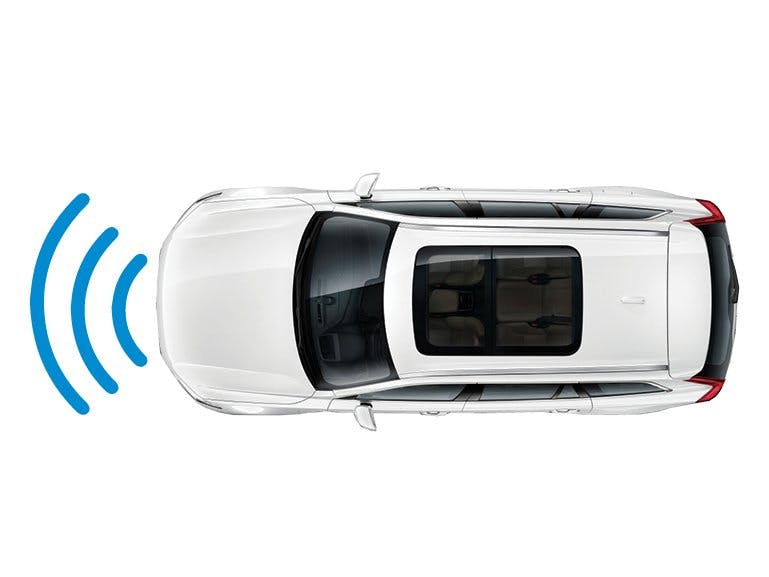Hardware components | ||||||
_ztBMuBhMHo.jpg?auto=compress%2Cformat&w=48&h=48&fit=fill&bg=ffffff) |
| × | 1 | |||
 |
| × | 10 | |||
| × | 1 | ||||
Assembly:
RGB Module from Jaycar
RGB Module
+ to Digital Pin 3 on UNO
G to Digital Pin 2 on UNO
R to Digital Pin 1 on UNO
B to Digital Pin 0 on UNO
Ultrasonic Sensor
VCC to Digital Pin 10 on UNO
Trig to Digital Pin 11 on UNO
Echo to Digital Pin 12 on UNO
GND to Digital Pin 13 on UNO
Note: Depending on what modules you have these instructions will differ. Try them anyway. There should be no bugs in the code. The RGB module is very bright so I tape paper to the front of mine.
//Ultrasonic Parking Assistant
//measures distance using ultrasonic sensor
//displays approximate closeness with colours on LED module
//Blue- out of range (3m typically)
//Green- in range, but far away
//Amber- closer
//Red- very close
#define GREENDISTANCE 200
#define AMBERDISTANCE 60
#define REDDISTANCE 30
// Ultrasonic HC-SR04 unit interface
//define pins here
//if using fixed power pins, set to a negative number, and they will be ignored
#define UVCC 10
#define UTRIG 11
#define UECHO 12
#define UGND 13
//define led module pins here, polarity is automatically handled by presence of LEDPLUS or LEDMINUS
//if LED's have common negative, use LEDMINUS
//if LED's have common positive, use LEDPLUS
//#define LEDMINUS 3
#define LEDPLUS 3
#define LEDBLUE 0
#define LEDRED 1
#define LEDGREEN 2
void setup(){
usonicsetup();
ledsetup();
}
void loop(){
byte r=0; //for red led
byte g=0; //for green led
byte b=0; //for blue led
long d; //for distance
d=usonic(17400)/58; //convert ping time to distance in cm
if(d==0){d=300;} //sometimes returns 0 when not in range
if(d<AMBERDISTANCE){r=1;} //turn on red LED if red or amber needs to be shown
if((d>=REDDISTANCE)&&(d<300)){g=1;} //turn on green LED if amber or green needs to be shown
if(d>=300){b=1;} //turn on blue otherwise, so you know it's working
ledset(r,g,b); //set the LED's
delay(200); //wait a bit so it won't flicker too much
}
void ledsetup(){ //set up led pins depending on whether they are common + or common -, turn all LED's off
#ifdef LEDPLUS
pinMode(LEDPLUS, OUTPUT);
digitalWrite(LEDPLUS, HIGH);
pinMode(LEDRED, OUTPUT);
digitalWrite(LEDRED, HIGH);
pinMode(LEDGREEN, OUTPUT);
digitalWrite(LEDGREEN, HIGH);
pinMode(LEDBLUE, OUTPUT);
digitalWrite(LEDBLUE, HIGH);
#endif
#ifdef LEDMINUS
pinMode(LEDMINUS, OUTPUT);
digitalWrite(LEDMINUS, LOW);
pinMode(LEDRED, OUTPUT);
digitalWrite(LEDRED, LOW);
pinMode(LEDGREEN, OUTPUT);
digitalWrite(LEDGREEN, LOW);
pinMode(LEDBLUE, OUTPUT);
digitalWrite(LEDBLUE, LOW);
#endif
}
void ledset(byte r, byte g, byte b){
#ifdef LEDPLUS
r=!r; //invert if we're using common +
g=!g;
b=!b;
#endif
digitalWrite(LEDRED, r); //set outputs
digitalWrite(LEDGREEN, g);
digitalWrite(LEDBLUE, b);
}
void usonicsetup(void){
if(UGND>-1){ //set up ground pin if defined
pinMode(UGND, OUTPUT);
digitalWrite(UGND, LOW);
}
if(UVCC>-1){ //set up VCC pin if defined
pinMode(UVCC, OUTPUT);
digitalWrite(UVCC, HIGH);
}
pinMode(UECHO, INPUT); //ECHO pin is input
pinMode(UTRIG, OUTPUT); //TRIG pin is output
digitalWrite(UTRIG, LOW);
}
long usonic(long utimeout){ //utimeout is maximum time to wait for return in us
long b;
if(digitalRead(UECHO)==HIGH){return 0;} //if UECHO line is still low from last result, return 0;
digitalWrite(UTRIG, HIGH); //send trigger pulse
delay(1);
digitalWrite(UTRIG, LOW);
long utimer=micros();
while((digitalRead(UECHO)==LOW)&&((micros()-utimer)<1000)){} //wait for pin state to change- return starts after 460us typically
utimer=micros();
while((digitalRead(UECHO)==HIGH)&&((micros()-utimer)<utimeout)){} //wait for pin state to change
b=micros()-utimer;
return b;
}









Comments